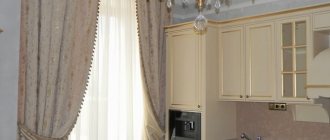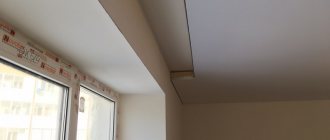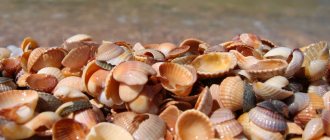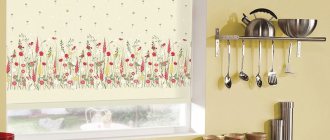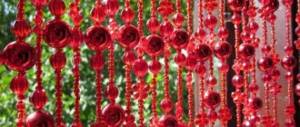Variety of curtain ties
On the Internet you can find a huge number of different photos of curtain tiebacks. These can be metal hooks or intricately shaped plastic elements.
In some interiors, tiebacks made of wood and leather are appropriate. Magnetic curtain tiebacks in the form of different geometric shapes are very convenient and popular.
Luxurious tiebacks are obtained by using beads or beads, satin ribbons, foamiran. Beautiful and elegant tiebacks are made from cords in combination with satin tassels.
Learn how to make a rigid curtain clamp with your own hands: master class
Rigid curtain holders are more suitable for modern interior styles. They look quite laconic and minimalistic.
To create rigid clamps, you can use the most unusual materials. For example, a holder in the form of a coffee cup without a bottom will look original.
For our version of tacks, you will need two tablespoons, a glue gun, a screwdriver, a drill, and self-tapping screws. Also, if you wish, you can complement the product with flat beads, rhinestones and any other decorative elements.
Master class on making spoon scoops:
Take a tablespoon and carefully bend its handle. The curved handle should be parallel to its round part.
The distance from the round part to the handle should be 1-1.5 cm. Drill two holes in the round part of the spoon with a drill. Glue decorative elements onto the handle using a glue gun. These can be rhinestones, beads or just fabric bows. Screw the spoon along the pre-made holes to the wall at the level of the window sill using a screwdriver. In this case, the convex part of the spoon should be pressed against the wall, and the end of the handle should look in the opposite direction from the window.
This design is convenient because it does not require additional hooks. To use it for its intended purpose, simply place the curtain in the space between the round part of the spoon and its handle.
Fabric tiebacks
If it is more convenient to buy metal or plastic hooks for curtain tiebacks in a store, then fabric tiebacks can be made at home. DIY curtain tiebacks will become an original piece of furniture.
Fabric curtain tiebacks are the most common. Often they already come complete with ready-made curtains. But any housewife has the opportunity to decorate her interior with a unique element and show her creativity.
In addition, fabric tiebacks are easy to care for - you can simply wash them in the washing machine on a gentle cycle.
There is a lot of information in various sources on how to sew tiebacks for fabric curtains. First you need to decide on the size. For thin, light curtains, 20-25 cm will be enough. Thick curtains made of velvet, blackout, and printed fabrics are more difficult to drape; they require tiebacks of about 30-40 cm, wider ones. Next, prepare a cardboard template. Fabric parts are cut out from it, carefully sewn together, and ironed.
How to sew a classic tie yourself
Above we looked at how to make curtain holders yourself from all kinds of decorative elements. Let's now look at a more classic fabric option. Sewing them is not difficult. Detailed instructions below.
What we need:
Any fabric is suitable for picking up. The main thing is that it matches the curtains.
- a piece of fabric;
- buttons, buttons;
- interlining;
- blade;
- ruler;
- chalk, you can use soap;
- a button press, if you decide to use buttons instead of buttons;
- scissors;
- iron.
Let's take a fabric, not necessarily the same color as the curtains, and not necessarily from the same material. When choosing a fabric, follow only one condition - it must fit harmoniously into the overall design of your interior. It is best if the fabric is dense, so it will retain its shape longer. For tiebacks, do not use fabric that stretches; it will not hold its shape. But if there is no dense fabric, a soft one will do, strengthen it with non-woven fabric. You can use material with all kinds of patterns and designs. But in this case, choose the location of the picture so that the symmetry is not broken.
Cutting and sewing tiebacks
So, first we need to make a pattern. To do this, take a sheet of thick paper or cardboard, the latter is preferable. Draw a rectangle on it with a pencil. The most commonly used size is 35x10 cm, but it all depends on the size of the curtains and your preferences. Place the resulting triangle on a piece of fabric. We will cut directly onto the fabric.
Related article: Door lock design: what does it consist of?
We take working fabric. Fold it in half and place it on our pattern.
The material should be laid so that its long side coincides with the fold line.
Pattern pattern for curtain ties.
Trace the cut out rectangle with chalk or soap. Then use a ruler to measure 50 mm on each side for allowances. Cut out the workpiece. We do the same with the second piece.
Take the first piece and fold it in half with the wrong side down. Now you need to iron the fold line. Then fold the seam allowances inward and iron over them. Fold the workpiece with the top side inward and sew so that one cut remains open. Now turn it inside out and sew up the remaining hole.
Next step. We make a loop from the braid and sew it into the tie. Then you need to mark the place where the hole for the button is planned. Use a blade to make a small cut. Sweep it. Sew a button on the opposite end of the braid.
It could be easier. For example, simply using a press to fasten buttons instead of buttons, they will last longer. By the way, the pickup can be decorated with beads. Do the same again with the second element.
Jewelry in kanzashi style
Tiebacks using decorations using the kanzashi technique are very interesting and easy to make yourself. Flowers or bows using the kanzashi technique are made from fabric squares, which are neatly folded and fixed in the desired sequence.
This decoration can be the same color as the curtains or contrasting. For elements using the kanzashi technique, it is preferable to use thin fabrics such as tulle and organza. Handicraft using the kanzashi technique requires patience and perseverance, but the result is worth it.
Braided or knitted tiebacks
Braided tiebacks look very homey. They are designed to support heavy curtains. Braided tiebacks can be made from various cords, thick threads, and twine.
Making such a decoration is not difficult - you can braid suitable threads, tie it in a knot, or make a beautiful weave according to the pattern. Satin tassels will be a beautiful addition to braided tiebacks.
Crocheted jewelry looks original. Most often these are flowers knitted in a circle. Beads can be used as decoration. For lovers of knitting, making such an interior element will be difficult and will take a minimum of time.
Tiebacks made of beads and beads
Such tiebacks are suitable for decorating curtains made of light and thin fabrics. These can simply be beautiful beads strung on threads in several rows. You can also use disused jewelry - beads, chains.
Making curtain decorations using beads is labor-intensive and painstaking work. But there is no doubt that such a decoration will become an exclusive and exquisite piece of furniture.
Cutting and sewing tiebacks
So, first we need to make a pattern. To do this, take a sheet of thick paper or cardboard, the latter is preferable. Draw a rectangle on it with a pencil.
The most commonly used size is 35x10 cm, but it all depends on the size of the curtains and your preferences. Place the resulting triangle on a piece of fabric. We will cut directly onto the fabric.
We take working fabric. Fold it in half and place it on our pattern.
The material should be laid so that its long side coincides with the fold line.
Pattern pattern for curtain ties.
Trace the cut out rectangle with chalk or soap.
Then use a ruler to measure 50 mm on each side for allowances. Cut out the workpiece. We do the same with the second piece.
Take the first piece and fold it in half with the wrong side down. Now you need to iron the fold line.
Then fold the seam allowances inward and iron over them. Fold the workpiece with the top side inward and sew so that one cut remains open. Now turn it inside out and sew up the remaining hole.
Next step. We make a loop from the braid and sew it into the tie. Then you need to mark the place where the hole for the button is planned.
Use a blade to make a small cut. Sweep it. Sew a button on the opposite end of the braid.
It could be easier.
For example, simply using a press to fasten buttons instead of buttons, they will last longer. By the way, the pickup can be decorated with beads. Do the same again with the second element.
How to choose a curtain tieback
The biggest difficulty in resolving the question of how to make curtain tiebacks is choosing something suitable from a huge number of creative design ideas.
Curtains for the kitchen - 120 real photos of new designs. Options for the ideal combination of modern curtains in the kitchen interior
- How to hang curtains - step-by-step instructions with photo examples and recommendations. Exclusive curtain design solutions from experienced craftswomen
Do-it-yourself tulle - step-by-step instructions on how to sew beautiful tulle. Photos of ready-made ideas and modern design
A huge advantage of this interior element is that the tiebacks can be changed even weekly, depending on your mood or capricious fashion.
The most ordinary curtain can be given style and unusualness to the room with the help of an original tieback.
DIY curtain tiebacks
Handmade curtain holders will become an original accessory for any interior. This does not require great skills, just a little ingenuity and creativity.
There are many available materials from which you can make curtain tiebacks with your own hands.:
- Strings of beads of various sizes and colors.
- Beautiful satin ribbons decorated with various elements.
- Cords of unusual weaves.
- Pieces of leather belts with interesting buckles.
For those who know how to use a crochet hook or knitting needles, it will not be difficult to make curtain tiebacks with your own hands; it will be enough to knit several patterns and, if desired, decorate them with some elements.
Armed with imagination and the necessary materials, you can make excellent curtain tiebacks with your own hands.
Whatever design option is chosen, it is important to remember that curtain holders must fit harmoniously into the general direction of the interior, while performing all the functions assigned to them.
Using Magnetic Holders
Magnetic holders come in a variety of colors, sizes, and shapes. They can be made of different materials: metal, plastic, glass. Magnetic holders are very convenient and easy to use.
The downside is that they can only be used to secure curtains made of light fabrics in a certain position. Magnetic clips can be used to grab the curtain in several places and fix the tulle at different levels.
What kind of curtain ties you can make yourself
Curtain ties can be completely invisible in interiors, or, on the contrary, they can add originality to the room. It all depends on what materials you use to create such accessories.
Usually, the hook is paired with a hook, which is mounted on the wall and holds the tied fabric in one position, however, there are options that do not need such elements.
Depending on the material from which they are made, curtain hooks are divided into several subtypes. If you decide to choose ties that require such additions, we recommend that you familiarize yourself with the list of the most popular materials for hooks.
Types of curtain hooks:
Plastic curtain hooks are one of the most inexpensive, and therefore popular, options.
Such products can have a wide variety of designs, so they fit perfectly into any interior. Metal hooks fit perfectly into modern interiors. They are very strong and durable. Wooden hooks are environmentally friendly and beautiful. There are carved options that are simply incredibly beautiful.
Curtain hooks are usually located at the level of the window sill, but can be mounted slightly higher. Such products are not always noticeable; very often they are hidden behind fabric.
The clamps themselves can be made from a variety of materials. Fabric, ribbons, strings of pearls, and even metal will suit you. You can make clips using only your imagination, or take advantage of one of our master classes.
Rules for choosing colors for tiebacks
The color of the tiebacks should be in harmony with the color of the curtain fabric. A tieback made from the same material as the curtains will most likely perform only a practical function - to hold the curtain. Beautiful tiebacks will decorate even an ordinary white curtain.
So, in the kitchen, a tieback, combined with a tablecloth, kitchen towel and potholders, will look original and elegant.
Curtains for gray wallpaper - options for the ideal combination of curtains in a gray interior (TOP-150 photos of new designs)
- Patchwork quilt - 130 photos of the best new items of 2020. Step-by-step instructions on how to sew a beautiful patchwork quilt with your own hands
Gray curtains are options for stylish interior design. TOP 100 photos of new designs for 2020
In a children's room, bright tie-backs decorated with toys, bows, and fairies would be appropriate.
Tiebacks in gold tones, decorated with fringe or tassels create a solemn look. They are used in living rooms decorated in classical or baroque style.
In rooms designed in a minimalist style, tiebacks can be a bright decorative accent.
How to make your own curtain tiebacks from ribbons
Ribbon tiebacks look very nice. However, such elements are quite difficult to make. Here you need to use patience and the skill of forming beautiful flowers from a ribbon.
If you don't want to spend a lot of time fiddling with ribbon to create beautiful products, you can purchase artificial flowers. By cutting off the stem and placing them on tape, you can quickly and easily create a stunning holder.
To create such a product, use a wide ribbon or satin fabric for the petals, a satin ribbon for the center of the flower, a satin ribbon or fabric for the leaves. You will also need the base of the holder itself; it can be made by putting together two boat-shaped elements made from ribbons and trimming them around the edges with ribbon braid; on both sides of this structure you need to make ties from a thin ribbon.
To make a flower you need to cut out five circles of the same diameter, fold them in half, and then in half again.
The rounded part of the resulting triangle needs to be basted and pulled together so that your workpiece takes the shape of a petal with folds. You need to do this with all the circles. Next, the circles are sewn together in a circle, and a circle or ball of fabric of a different color is inserted into the middle. In total, for one holder you need to make two such flowers. To make petals, you need to cut circles of larger diameter from green fabric.
Next, they need to be folded, basted and pulled together according to the same principle as the petals. To put the tie together, you need to glue or sew leaves onto the base, and attach flowers to them. In this case, the flowers should cover the sloppy edges of the leaves. For this pot holder you will need a hook.
Holders for curtain tiebacks
Holders, like the grabbers themselves, can be either simple or original. The most common and accessible holders are in the form of a hook. Such holders are mounted on the wall. They hold even heavy curtains securely.
Objects that are not directly intended for this purpose can be used as holders. For example, door handles. It is convenient to quickly throw a curtain over the door handle, thereby opening up the space for daylight.
The final element when decorating a room
Curtain tiebacks serve not only for beautiful draping of curtain fabric - they add elegance and comfort to the room.
Curtain tiebacks are the final element when creating the style of a room. Therefore, when decorating curtains, you should definitely pay attention to such a detail as the tieback.
Photos of curtain tiebacks
Did you like the article? Share 
0

